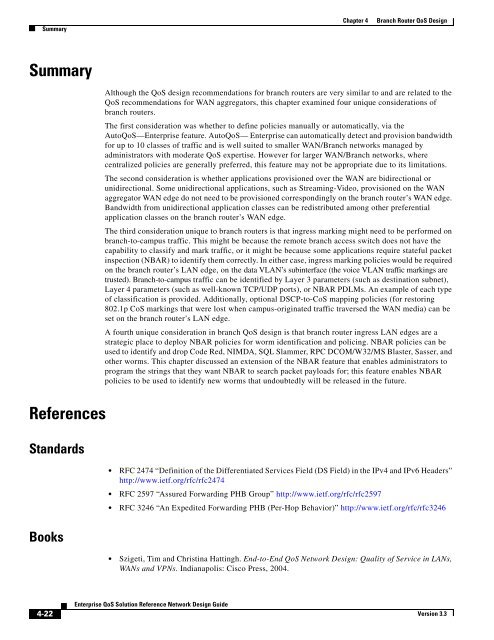Enterprise QoS Solution Reference Network Design Guide
Enterprise QoS Solution Reference Network Design Guide
Enterprise QoS Solution Reference Network Design Guide
Create successful ePaper yourself
Turn your PDF publications into a flip-book with our unique Google optimized e-Paper software.
Summary<br />
Summary<br />
<strong>Reference</strong>s<br />
Standards<br />
Books<br />
4-22<br />
<strong>Enterprise</strong> <strong>QoS</strong> <strong>Solution</strong> <strong>Reference</strong> <strong>Network</strong> <strong>Design</strong> <strong>Guide</strong><br />
Chapter 4 Branch Router <strong>QoS</strong> <strong>Design</strong><br />
Although the <strong>QoS</strong> design recommendations for branch routers are very similar to and are related to the<br />
<strong>QoS</strong> recommendations for WAN aggregators, this chapter examined four unique considerations of<br />
branch routers.<br />
The first consideration was whether to define policies manually or automatically, via the<br />
Auto<strong>QoS</strong>—<strong>Enterprise</strong> feature. Auto<strong>QoS</strong>— <strong>Enterprise</strong> can automatically detect and provision bandwidth<br />
for up to 10 classes of traffic and is well suited to smaller WAN/Branch networks managed by<br />
administrators with moderate <strong>QoS</strong> expertise. However for larger WAN/Branch networks, where<br />
centralized policies are generally preferred, this feature may not be appropriate due to its limitations.<br />
The second consideration is whether applications provisioned over the WAN are bidirectional or<br />
unidirectional. Some unidirectional applications, such as Streaming-Video, provisioned on the WAN<br />
aggregator WAN edge do not need to be provisioned correspondingly on the branch router’s WAN edge.<br />
Bandwidth from unidirectional application classes can be redistributed among other preferential<br />
application classes on the branch router’s WAN edge.<br />
The third consideration unique to branch routers is that ingress marking might need to be performed on<br />
branch-to-campus traffic. This might be because the remote branch access switch does not have the<br />
capability to classify and mark traffic, or it might be because some applications require stateful packet<br />
inspection (NBAR) to identify them correctly. In either case, ingress marking policies would be required<br />
on the branch router’s LAN edge, on the data VLAN’s subinterface (the voice VLAN traffic markings are<br />
trusted). Branch-to-campus traffic can be identified by Layer 3 parameters (such as destination subnet),<br />
Layer 4 parameters (such as well-known TCP/UDP ports), or NBAR PDLMs. An example of each type<br />
of classification is provided. Additionally, optional DSCP-to-CoS mapping policies (for restoring<br />
802.1p CoS markings that were lost when campus-originated traffic traversed the WAN media) can be<br />
set on the branch router’s LAN edge.<br />
A fourth unique consideration in branch <strong>QoS</strong> design is that branch router ingress LAN edges are a<br />
strategic place to deploy NBAR policies for worm identification and policing. NBAR policies can be<br />
used to identify and drop Code Red, NIMDA, SQL Slammer, RPC DCOM/W32/MS Blaster, Sasser, and<br />
other worms. This chapter discussed an extension of the NBAR feature that enables administrators to<br />
program the strings that they want NBAR to search packet payloads for; this feature enables NBAR<br />
policies to be used to identify new worms that undoubtedly will be released in the future.<br />
RFC 2474 “Definition of the Differentiated Services Field (DS Field) in the IPv4 and IPv6 Headers”<br />
http://www.ietf.org/rfc/rfc2474<br />
RFC 2597 “Assured Forwarding PHB Group” http://www.ietf.org/rfc/rfc2597<br />
RFC 3246 “An Expedited Forwarding PHB (Per-Hop Behavior)” http://www.ietf.org/rfc/rfc3246<br />
Szigeti, Tim and Christina Hattingh. End-to-End <strong>QoS</strong> <strong>Network</strong> <strong>Design</strong>: Quality of Service in LANs,<br />
WANs and VPNs. Indianapolis: Cisco Press, 2004.<br />
Version 3.3
















